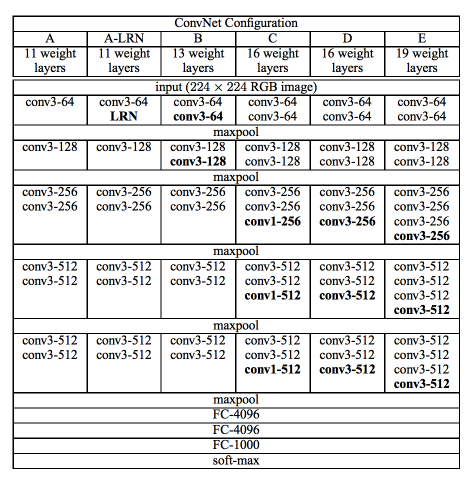import torch
model = torch.hub.load('pytorch/vision:v0.10.0', 'vgg11', pretrained=True)
# or any of these variants
# model = torch.hub.load('pytorch/vision:v0.10.0', 'vgg11_bn', pretrained=True)
# model = torch.hub.load('pytorch/vision:v0.10.0', 'vgg13', pretrained=True)
# model = torch.hub.load('pytorch/vision:v0.10.0', 'vgg13_bn', pretrained=True)
# model = torch.hub.load('pytorch/vision:v0.10.0', 'vgg16', pretrained=True)
# model = torch.hub.load('pytorch/vision:v0.10.0', 'vgg16_bn', pretrained=True)
# model = torch.hub.load('pytorch/vision:v0.10.0', 'vgg19', pretrained=True)
# model = torch.hub.load('pytorch/vision:v0.10.0', 'vgg19_bn', pretrained=True)
model.eval()
All pre-trained models expect input images normalized in the same way,
i.e. mini-batches of 3-channel RGB images of shape (3 x H x W), where H and W are expected to be at least 224.
The images have to be loaded in to a range of [0, 1] and then normalized using mean = [0.485, 0.456, 0.406]
and std = [0.229, 0.224, 0.225].
Here’s a sample execution.
# Download an example image from the pytorch website
import urllib
url, filename = ("https://github.com/pytorch/hub/raw/master/images/dog.jpg", "dog.jpg")
try: urllib.URLopener().retrieve(url, filename)
except: urllib.request.urlretrieve(url, filename)
# sample execution (requires torchvision)
from PIL import Image
from torchvision import transforms
input_image = Image.open(filename)
preprocess = transforms.Compose([
transforms.Resize(256),
transforms.CenterCrop(224),
transforms.ToTensor(),
transforms.Normalize(mean=[0.485, 0.456, 0.406], std=[0.229, 0.224, 0.225]),
])
input_tensor = preprocess(input_image)
input_batch = input_tensor.unsqueeze(0) # create a mini-batch as expected by the model
# move the input and model to GPU for speed if available
if torch.cuda.is_available():
input_batch = input_batch.to('cuda')
model.to('cuda')
with torch.no_grad():
output = model(input_batch)
# Tensor of shape 1000, with confidence scores over ImageNet's 1000 classes
print(output[0])
# The output has unnormalized scores. To get probabilities, you can run a softmax on it.
probabilities = torch.nn.functional.softmax(output[0], dim=0)
print(probabilities)
# Download ImageNet labels
!wget https://raw.githubusercontent.com/pytorch/hub/master/imagenet_classes.txt
# Read the categories
with open("imagenet_classes.txt", "r") as f:
categories = [s.strip() for s in f.readlines()]
# Show top categories per image
top5_prob, top5_catid = torch.topk(probabilities, 5)
for i in range(top5_prob.size(0)):
print(categories[top5_catid[i]], top5_prob[i].item())
Model Description
Here we have implementations for the models proposed in Very Deep Convolutional Networks for Large-Scale Image Recognition, for each configurations and their with batchnorm version.
For example, configuration A presented in the paper is vgg11, configuration B is vgg13, configuration D is vgg16
and configuration E is vgg19. Their batchnorm version are suffixed with _bn.
Their Top-1 error rates on ImageNet dataset with pretrained models are listed below.
| Model structure | Top-1 error | Top-5 error |
|---|---|---|
| vgg11 | 30.98 | 11.37 |
| vgg11_bn | 26.70 | 8.58 |
| vgg13 | 30.07 | 10.75 |
| vgg13_bn | 28.45 | 9.63 |
| vgg16 | 28.41 | 9.62 |
| vgg16_bn | 26.63 | 8.50 |
| vgg19 | 27.62 | 9.12 |
| vgg19_bn | 25.76 | 8.15 |


